Laramie, Wyoming - Wikipedia
Laramie is a city and the county seat of Albany County,
Wyoming, United States. The population was 30,816 at the 2010 census. Located
on the Laramie River in southeastern Wyoming, the city is west of Cheyenne,
at the junction of Interstate 80 and U.S. Route 287.
Laramie was settled in the mid-19th century along the
Union Pacific Railroad line, which crosses the Laramie River at Laramie.
It is home to the University of Wyoming, Wyoming Technical Institute, and
a branch of Laramie County Community College. Laramie Regional Airport
serves Laramie. The ruins of Fort Sanders, an army fort predating Laramie,
lie just south of the city along Route 287. Located in the Laramie Valley
between the Snowy Range and the Laramie Range, the city draws outdoor enthusiasts
with its abundance of outdoor activities.
In 2011, Laramie was named as one of the best cities in
which to retire by Money Magazine, which cited its scenic location, low
taxes, and educational opportunities.
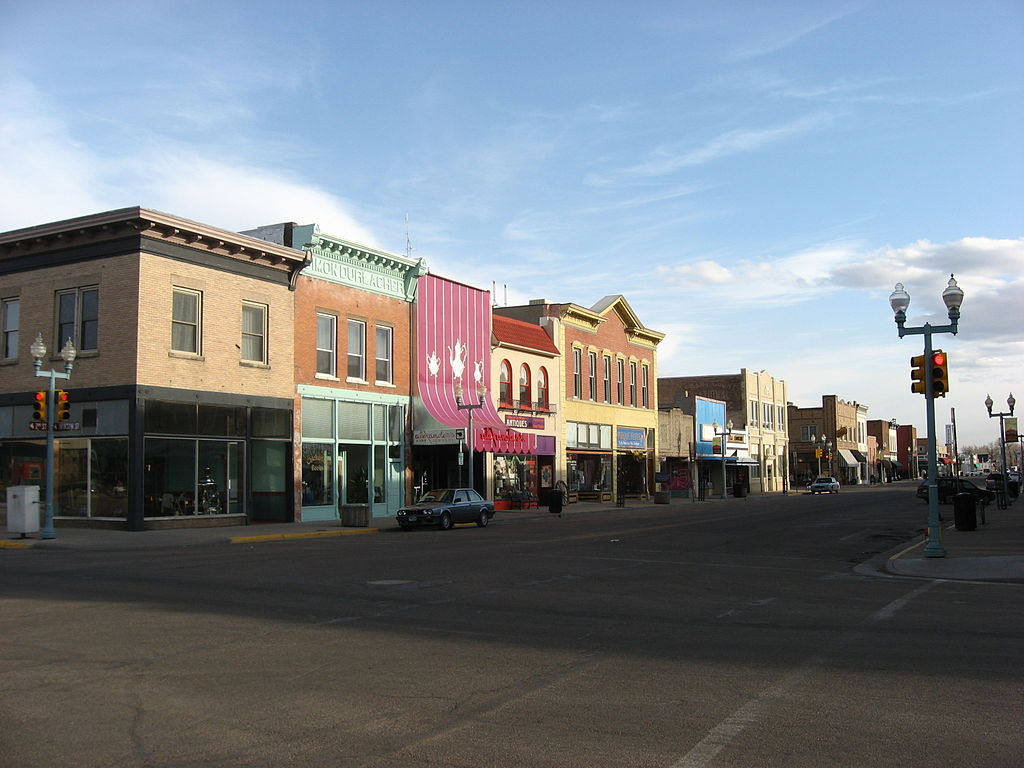
Downtown District |
History
Laramie was named for Jacques LaRamie, a French or French-Canadian
trapper who disappeared in the Laramie Mountains in the late 1810s and
was never heard from again. He was one of the first Europeans to visit
the area. European-American settlers named a river, mountain range, peak,
US Army fort, county, and city for him. More Wyoming landmarks are named
for him than for any other trapper but Jim Bridger. Because the name was
used so frequently, the town was called Laramie City for decades to distinguish
it from other uses.
Laramie was founded in the mid-1860s as a tent city near
the Overland Stage Line route, the Union Pacific portion of the first transcontinental
railroad, and just north of Fort Sanders army post. The rails reached Laramie
on May 4, 1868 when construction crews worked through town. A few passengers
arrived on that same day. The first regular passenger service began on
May 10, 1868, by which time entrepreneurs were building more permanent
structures. Laramie City (as it was known in early years) soon had stores,
houses, a school, and churches. Laramie's fame as the western terminal
of the Union Pacific Railroad, acquired when the 268-mile (431 km) section
from North Platte, Nebraska was opened in May ended in early August 1868
when a 93-mile (150 km) section of track was opened to Benton, 6 miles
(9.7 km) east of present-day Sinclair, Wyoming.
Laramie suffered initially from lawlessness. Its first
mayor, M. C. Brown, resigned his office on June 12, 1868 after six turbulent
weeks, saying that the other officials elected alongside him on May 2 were
guilty of "incapacity and laxity" in dealing with the city's problems.
This was due to the threat to the community from three half-brothers, early
Old West gunman "Big" Steve Long, Con Moyer and Ace Moyer. Long was Laramie's
first marshal, and with his brothers owned the saloon Bucket of Blood.
The three began harassing settlers, forcing them to sign over the deeds
to their property to them. Any who refused was killed, usually goaded into
a gunfight by Long. By October 1868, Long had killed 13 men.
The first Albany County sheriff, rancher N. K. Boswell,
organized a "Vigilance Committee" in response. On October 28, 1868, Boswell
led the committee into the Bucket of Blood, overwhelmed the three brothers,
and lynched them at an unfinished cabin down the street. Through a series
of other lynchings and other forms of intimidation, the vigilantes reduced
the "unruly element" and established a semblance of law and order.
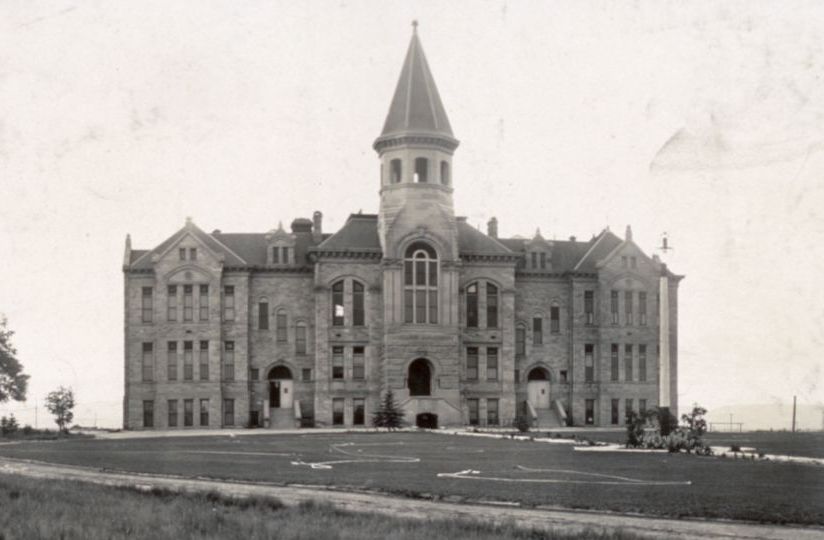 |
In 1869, Wyoming was organized as Wyoming Territory,
the first legislature of which passed a bill granting equal political rights
to women in the territory. In March 1870, five Laramie residents became
the first women in the world to serve on a jury. As Laramie was the first
town in Wyoming to hold a municipal election, on September 6, 1870, a Laramie
resident was the first woman in the United States to cast a legal vote
in a general election.
Early businesses included rolling mills, a railroad-tie
treatment plant, a brick yard, a slaughterhouse, a brewery, a glass manufacturing
plant, and a plaster mill, as well as the railroad yards. In 1886, a plant
to produce electricity was built. Several regional railroads were based
in Laramie, including the Laramie, North Park and Pacific Railroad and
Telegraph Company founded in 1880 and the Laramie, North Park and Western
Railroad established in 1901.
|
Governor Francis E. Warren signed a bill that established
the University of Wyoming (UW) in 1886, the only public university in the
state. Laramie was chosen as its site, and UW opened there in 1887. Under
the terms of the Morrill Act, also known as the Land Grant College Act,
in 1891 UW added an agricultural college and experiment station to gain
benefits as a land grant college.
Late 20th century to present
The city was covered by international media in 1998 after
the murder of Matthew Shepard, a gay student at the University of Wyoming.
His murder generated an international outcry. It became the symbolic focus
for a nationwide campaign against gay hate crimes. Federal hate crimes
legislation was signed into law in 2009. As of January 2011, Wyoming does
not have a hate crimes law. Shepard's murder was the subject of the award-winning
play, later adapted as a movie, The Laramie Project.
In 2004, Laramie became the first city in Wyoming to pass
a law to prohibit smoking in enclosed workplaces, including bars, restaurants
and private clubs. Opponents of the clean indoor air ordinance, funded
in part by the R.J. Reynolds Tobacco Company, immediately petitioned to
have the ordinance repealed. However, the voters upheld the ordinance in
a citywide referendum which was conducted concurrently with the 2004 general
election. The opponents challenged the validity of the election in court,
claiming various irregularities. However, the judge ruled that the opponents
had failed to meet their burden of showing significant problems with the
election, and the ordinance, which had become effective in April 2005,
remained in effect. In August 2005, Laramie's City Council defeated an
attempt to amend the ordinance to allow smoking in bars and private clubs.

Laramie, 1908 |
|
Cheyenne, Wyoming - from Wikipedia
Cheyenne (/?a??æn/ shy-AN or /?a???n/) is the capital
and most populous city of the US state of Wyoming and the county seat of
Laramie County. It is the principal city of the Cheyenne, Wyoming, Metropolitan
Statistical Area which encompasses all of Laramie County. The population
was 59,466 at the 2010 census. Cheyenne is the northern terminus of the
extensive and fast-growing Front Range Urban Corridor that stretches from
Cheyenne to Pueblo, Colorado, and has a population of 4,333,742 according
to the 2010 United States Census. Cheyenne is situated on Crow Creek and
Dry Creek. The Cheyenne, Wyoming Metropolitan Area had a 2010 population
of 91,738, making it the 354th most populous metropolitan area in the United
States.
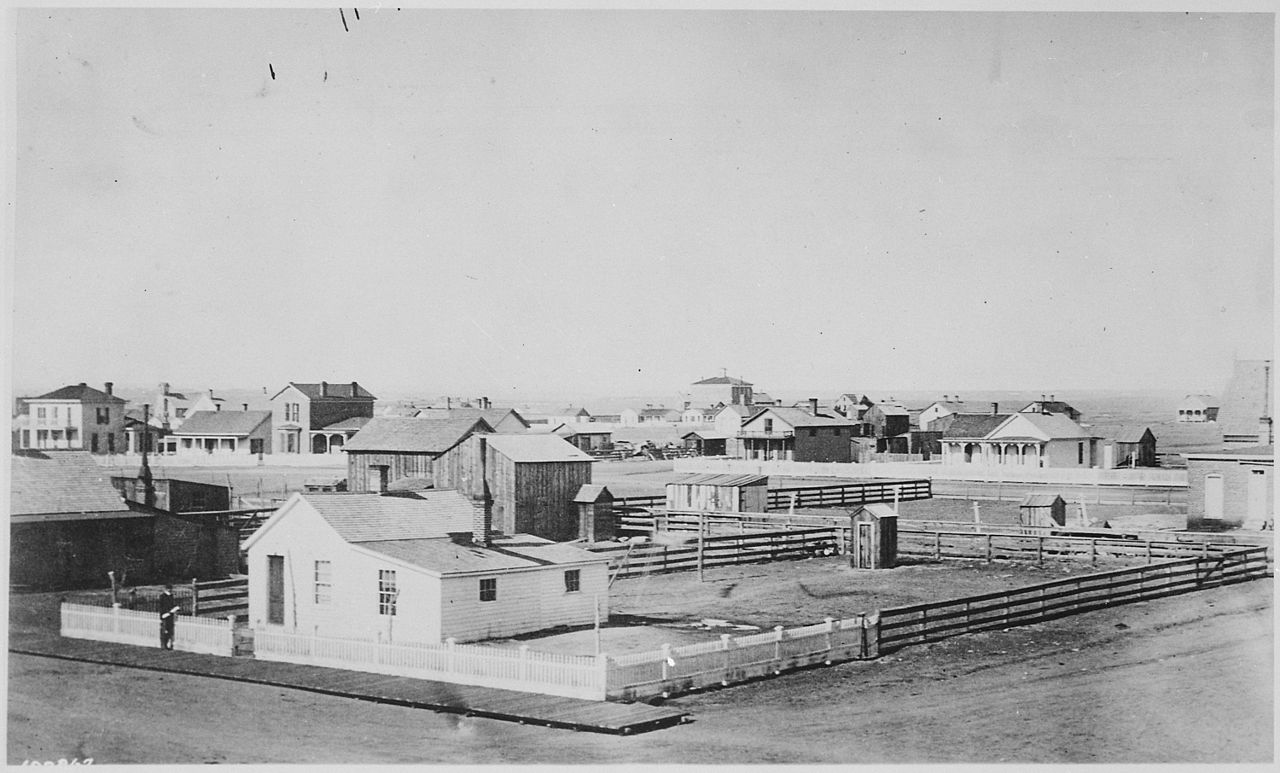
Cheyenne, 1876
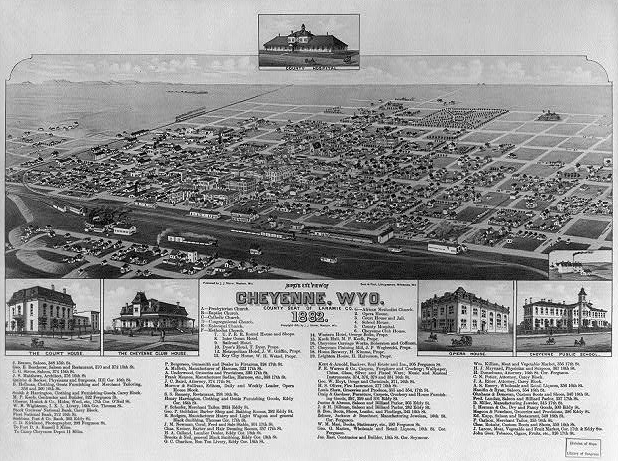
Bird's eye view of Cheyenne, 1882
|
On July 5, 1867, General Grenville M. Dodge and his survey
crew platted the site now known as Cheyenne in Dakota Territory (later
Wyoming Territory). This site was chosen as the point at which the Union
Pacific Railroad crossed Crow Creek, a tributary of the South Platte River.
The city was not named by Dodge, as his memoirs state, but rather by friends
who accompanied him to the area Dodge called "Crow Creek Crossing". It
was named for the American Indian Cheyenne nation, one of the most famous
and prominent Great Plains tribes closely allied with the Arapaho.
The construction of the Union Pacific Railroad brought
hopes of prosperity to the region when it reached Cheyenne on November
13, 1867. The population at the time numbered over 4,000, and grew rapidly.
This rapid growth earned the city the nickname "Magic City of the Plains".
In 1867, Fort D. A. Russell was established, three miles
west of the city. The fort was later renamed Francis E. Warren Air Force
Base.
The Wyoming State Capitol was constructed between 1886
and 1890, with further improvements being completed in 1917.
The Wyoming Stock Growers Association met at The Cheyenne
Club, which allegedly acted as an interim government for the territory.
Many of the WSGA's rules and regulations became state laws.
The Cheyenne Regional Airport was opened in 1920, initially
serving as a stop for airmail. It soon developed into a civil-military
airport, serving DC-3s and various military craft. During World War II,
hundreds of B-17s, B-24s, and PBYs were outfitted and upgraded at the airfield.
Today, it serves a number of military functions, as well as a high-altitude
testbed for civilian craft. |
|
| Medicine Bow, Wyoming - Wikipedia
Medicine Bow is a town in Carbon County, Wyoming, United
States. The population was 284 at the 2010 census.
History 19th and 20th century
This section does not cite any sources. Please help
improve this section by adding citations to reliable sources. Unsourced
material may be challenged and removed. (August 2014)
Medicine Bow, like many other towns across southern Wyoming,
was established as a result of the construction of the transcontinental
railroad in 1868. The railroad located a tie boom on the nearby Medicine
Bow River and built a depot, water stop, and coal-loading facility. Later,
livestock loading-pens were built and Medicine Bow became an important
livestock shipping center. The first load of cattle shipped to the Union
Stockyards in Omaha came from the Medicine Bow area. The town grew up around
the railroad facilities. In the middle 1880s, Philadelphia lawyer Owen
Wister stopped in town and wrote a description in his journal. He later
used the historic setting of Medicine Bow as a backdrop for his novel The
Virginian, which is considered to be the first novel of the "Western" Genre.
In the early 1900s Medicine Bow was one of the automobile stops on Old
Lincoln Highway (Junction of Hwys 30/287 and 487). August Grimm built the
Virginian Hotel to accommodate travelers. On June 26, 1909, the city was
incorporated.
In the early 1970s, the town suffered as a result of the
opening of Interstate Highway 80 that bypassed the town, some 35 miles
to the south. An economic boom began in the middle 1970s when uranium mines
opened north of town and coal mines west of town expanded production. In
1976, as a bicentennial project, local civic groups helped relocate the
Owen Wister Cabin, built by the Wister family in the Grand Tetons in northwestern
Wyoming, to a site next to the depot. David L. Roberts (b. Lusk, Wyoming,
1954) founded the Medicine Bow Post newspaper in 1977, editing and publishing
it until the early 1990s. Ownership of the original Union Pacific Depot,
which had burned in the early 20th century and was replaced in 1978, was
transferred to the City of Medicine Bow, and the town museum was started
in the structure.
Medicine Bow is one of the windiest places in America.
South of town, the first experimental giant wind turbines in Wyoming were
built under contract from the U. S. Bureau of Reclamation in the early
1980s. Utility-operated wind farms provide electricity from windy points
near Medicine Bow.
History 21st century
In December 2007, plans were announced for construction
of a large coal gasification plant to be built southwest of town. As of
April 2011 construction was to begin on the concrete pad. Completion date
was originally estimated for 2014. According to an article on WSJ 11/5/2012,
China Petrochemical Corp is planning to build an advanced facility here
that will convert coal into gasoline. The cost will be around $2B, and
it will produce 2300 construction jobs and 400 full-time jobs when the
facility goes into operation. China Petrochemical will gain the technological
know-how through this project and will use Chinese made materials to build
the plant to gain the cost advantage.As of Feb 2015, this project has been
put on indefinite hold due to the low cost of crude oil in the US Hanna
Headlamp.
The plant on 200 acres "a few miles up County Road 3 from
Elk Mountain and about a dozen miles south of Medicine Bow" would use coal
from the nearby underground Saddleback Hills mine and Elk Mountain surface
coal mine, turning it into 11,700 barrels of gasoline and carbon dioxide
each day. The company plans to use the carbon dioxide "for sale and use
in oil recovery". In 2013, Houston based DKRW Advanced Fuels had submitted
new construction plans for the $1.75 billion plant, and announced a construction
start date of July 1, 2014.
Expected temporary works to the town is an average of
972 workers per quarter over a four-year build, and when the plant is complete
435 full-time workers to operate the plant (285 in the coal mine and 150
in the coal-to-gas plant) The company estimates to spend about $35 million
for the payroll and $200 million on operations and maintenance annually.
The town celebrated its 100th anniversary of incorporation
on June 26, 2009.
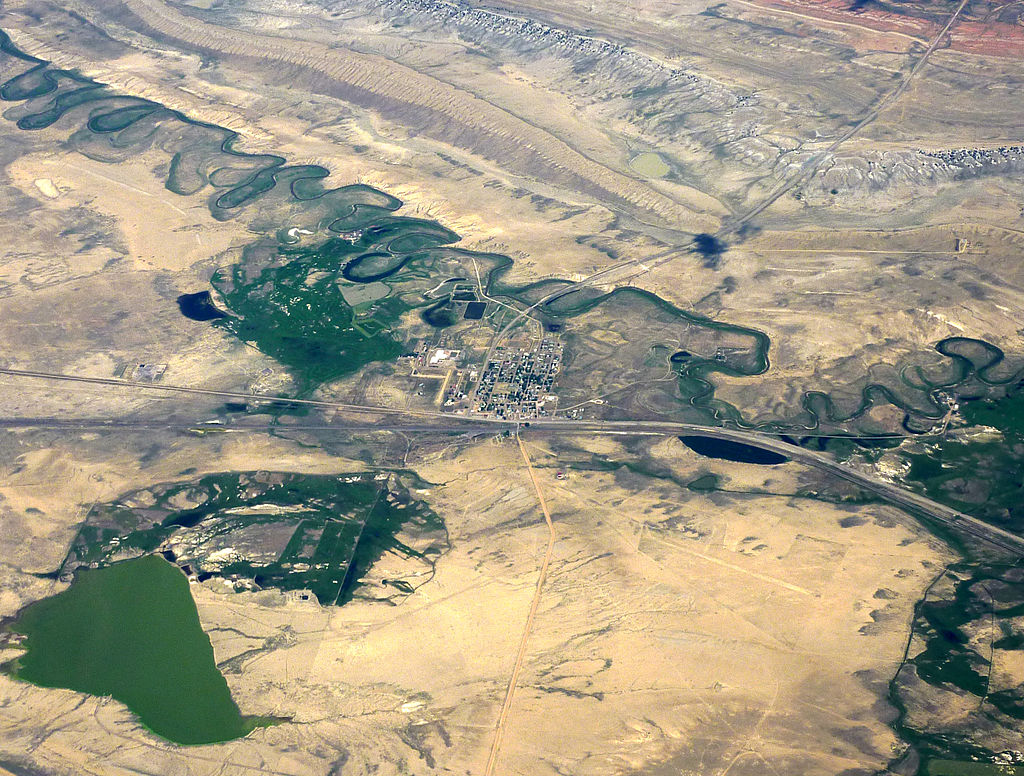
Aerial view of Medicine Bow |
|
.
All articles submitted to the "Brimstone
Gazette" are the property of the author, used with their expressed permission.
The Brimstone Pistoleros are not
responsible for any accidents which may occur from use of loading
data, firearms information, or recommendations published on the Brimstone
Pistoleros web site. |
|